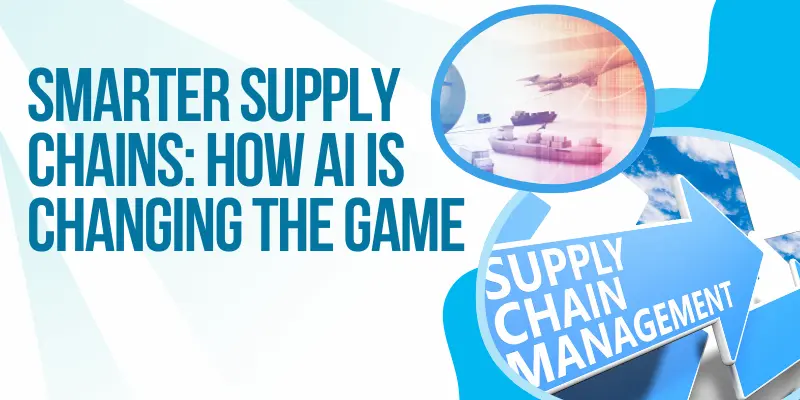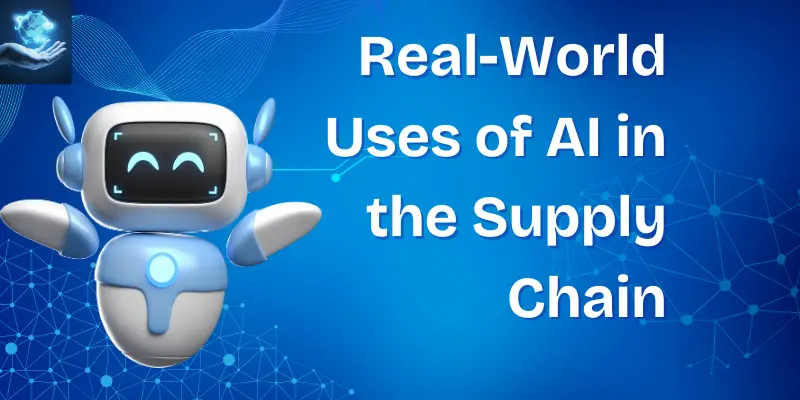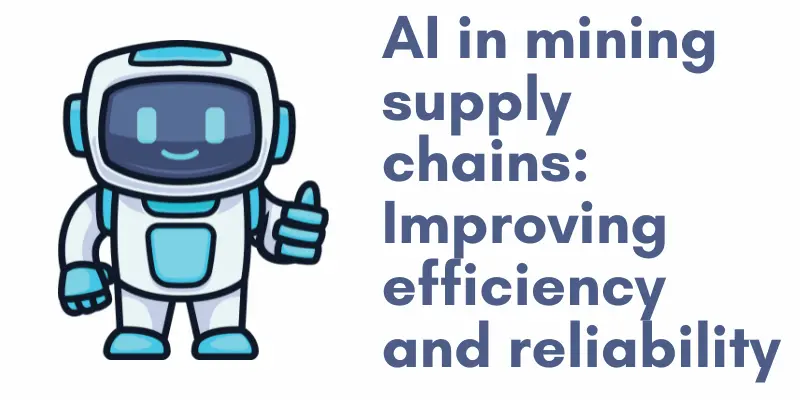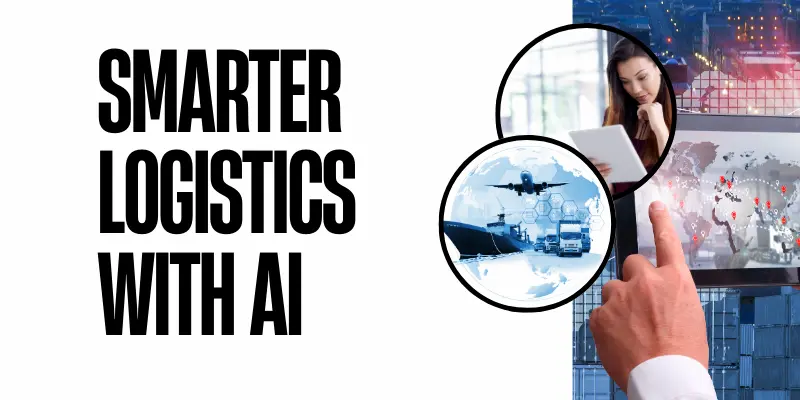AI in Supply Chain Management: Boost Efficiency, Cut Costs & Streamline Operations
Published: 19 May 2025
From my own experience managing operations in a mid-sized warehouse, I’ve seen firsthand how AI in supply chain management has become a true game-changer. It’s not just about automation—it’s about making smarter, faster decisions. AI tools optimize every part of the process, from inventory planning to logistics, improving efficiency at every step.
Instead of reacting to issues after they occur, AI in supply chain management helps companies make better-informed decisions early on. For example, it predicts machine maintenance needs in manufacturing to prevent downtime and tracks equipment usage in real time. This not only improves workflows but also keeps the entire system running smoothly while saving costs.
By combining data across operations, AI in supply chain management provides managers with clearer insights and greater control. Whether forecasting demand or routing shipments, this technology is no longer optional—it’s essential for staying competitive.
Smarter Supply Chains – How AI is Changing the Game
In today’s fast-paced world, businesses rely on AI not just as a trend but as a means to optimize the management of goods flow. From sourcing raw materials to manufacturing and final delivery, AI-powered systems help companies operate more efficiently and stay ahead of the competition.

I’ve seen firsthand how using AI-enabled tools simplifies even the most complex supply chains, cutting down the time and effort needed from multiple teams like procurement, QA, and production.
Whether a large enterprise or a small startup, every business can now tap into powerful supply chain management solutions. Thanks to greater availability, these tools are no longer limited to big corporations. They offer easy access to transformative tech that helps improve internal processes and gives better insights into real-time data. This evolution isn’t just technical – it’s practical. AI in web business models is playing a major role in enabling smarter, more agile supply chains. By working closely with these tools, I’ve seen how processes can be streamlined across all sizes of organizations, building stronger, smarter supply chains.
Real-World Uses of AI in the Supply Chain
In my years working with tech-driven businesses, I’ve seen firsthand how AI in supply chain management is changing the game. Many companies are now automating and monitoring complex individual tasks and communications to make operations smoother.

For example, digital assistants and AI copilots can now automatically handle routine communication by responding to supplier inquiries, confirming orders, and updating delivery statuses. This helps streamline communication, reduce delays, and keep every link in the supply chain more connected.
More impressively, machine learning algorithms can analyze huge amounts of data from various sources in real-time. This lets companies spot anomalies, identify patterns, and predict potential delays or bottlenecks before they disrupt operations. I’ve also used AI to streamline operations by dynamically adjusting inventory levels, notifying impacted parties of potential issues, and managing shipment progress efficiently. AI also helps in purchase order creation and management, making the movement of resources through the supply chain smarter and more responsive.
How AI Operates Within the Supply Chain
From my personal experience working with digital systems in logistics, I’ve seen firsthand how AI technologies have changed the way we think about supply chain management. Many businesses today use AI applications that are either trained on large datasets collected from various stages of the chain or follow predefined rules and mathematical models. These systems are implemented to analyze massive amounts of data from all corners of a business, from warehouse locations and supplier performance data to customer demand data and weather conditions. This allows them to optimize processes across departments, reducing waste and errors that were once common without tech assistance.
Most of these data-driven tools rely on machine learning models, optimization algorithms, and even generative AI to uncover patterns and give real-time insights that help enhance decision-making. For example, by looking at inventory data such as stock levels, reorder points, and uptime of machinery, AI systems can detect potential risks before they disrupt the supply chain. I’ve also worked with platforms that process transportation data, shipping routes, and fuel usage to find the most efficient ways to move goods. These specialized AI solutions create a holistic view of the system by connecting inputs like supplier cost data, macroeconomic indicators, and compliance data, making the entire operation more affordable and less dependent on manual systems. It’s this kind of deeper visibility that lets us work smarter, not harder.
AI in mining supply chains: Improving efficiency and reliability
In the mining industry, AI plays a key role in making the supply chain more efficient and reliable, especially during the early stages of operations. By analyzing large amounts of sensor data from critical equipment like trucks and drills, AI can learn from historical data to predict potential equipment failures.

This helps maintenance teams to intervene early and prevent costly breakdowns.
AI also optimizes the routes of autonomous haulage systems (AHS) in real-time, making sure trucks follow the most efficient paths to conserve fuel. From my experience, using AI in mining not only saves money but also improves safety and reduces downtime. This smart use of technology is transforming mining supply chains by making them faster and more dependable.
How AI improves warehouse management
Many businesses today are significantly enhancing their warehouse and inventory management by using AI. These AI systems work by analyzing vast amounts of data like customer orders, inventory levels, and product movement. This helps companies accurately forecast demand and ensure optimal stock levels. With these AI-driven insights, companies can reorganize warehouse layouts to maximize space efficiency and reduce retrieval times.
From my experience, using AI not only speeds up order fulfillment but also improves overall operational efficiency. Techniques like demand forecasting, stock optimization, and inventory control make logistics smoother and more reliable. The combination of automation, data analysis, and predictive analytics helps businesses achieve major performance improvements and efficiency gains in their supply chain operations, making order accuracy and fulfillment speed better than ever before.
Smarter Logistics with AI
From my work in logistics consulting, I’ve seen firsthand how logistics companies have transformed their operations using AI-enabled systems. These smart systems can analyze huge amounts of data, including package information, delivery locations, traffic patterns, and even weather conditions.

What impressed me the most was how AI can identify the most efficient routes in real time, adjusting on the fly based on changing road or weather updates. This kind of technology doesn’t just make operations smoother; it saves millions of miles of driving annually, which means fewer delays and faster deliveries.
This shift has a big impact on business performance, too. By optimizing delivery routes, companies are reducing fuel consumption, lowering operational costs, and improving both the reliability and predictability of delivery times. One small change, like AI suggesting a better route due to storm alerts, can prevent hours of delays. That’s why investing in this area is no longer optional — it’s essential for staying competitive in today’s fast-paced supply chains.
Words used: logistics companies, AI-enabled systems, optimize, delivery routes, systems, analyze, data, package information, delivery locations, traffic patterns, weather conditions, identify, most efficient routes, real-time, technology, saves, millions, miles, driving, annually, reducing, fuel consumption, operational costs, improving, reliability, predictability, delivery times
Smarter Supply Chains with AI
In my years of working closely with supply chain management, one thing is clear – using AI technologies has completely changed the game. Companies are now automating routine tasks and repetitive tasks to let human resources focus on strategic activities. With predictive maintenance, systems can alert teams before machinery breaks down, adjusting production schedules to reduce equipment downtime and keep operations smooth. That’s a massive win in improved equipment reliability and real-time decision-making.
I’ve also seen how predictive analytics and real-time insights help businesses make informed decisions during unexpected market conditions or even global events. They now benefit from better accuracy, avoiding mistakes from manual data entry, and improving demand forecasting with deeper insights. In one project, we used digital twins and 3D virtual modeling to redesign facility layouts, which greatly improved workforce efficiency. Tools like generative AI and copilots made it easier for staff to access the right resources faster.
When we talk about supplier management, AI is now used to analyze performance metrics, run price comparisons, and support vendor selection, all helping to streamline procurement, gain favorable terms, and reduce costs and time. AI can also help in identifying risks like supplier failures or market fluctuations, so teams can build contingency plans to boost supply chain resilience. Cloud-based computing enables scalability, handling larger volumes of data and complex supply chain networks on demand. And finally, sustainability compliance helps track environmental impact, ensuring corporate citizens meet regulatory requirements and make progress toward sustainability goals. With end-to-end visibility, AI improves transparency, tracking, and helps businesses spot bottlenecks, detect delays, and take corrective action early.
5 Challenges of AI in Supply Chain Management
Working with AI in supply chain management brings big opportunities, but it also comes with important challenges. From my own experience consulting with mid-sized organizations, I’ve seen how a lack of proper planning and research can stall projects before they even start. One of the biggest issues is data challenges, especially when teams rely on inaccurate or irrelevant data. These inputs affect AI models and limit their ability to deliver reliable insights, recommendations, or even actionable insights. Without meaningful insights, businesses struggle to improve performance or decision-making. It’s critical to fully grasp the capability and applicability of AI so teams can avoid complicated paths when identifying, scoping, and prioritizing efforts. Skipping proper steps in assessing the cost/benefit of different AI use cases often leads to wasted time and missed value.
Another roadblock is keeping up with evolving regulations. With concerns around privacy, security, and the ethical implications of automation, companies must establish clear guidelines to ensure the responsible use of AI. In one firm I worked with, organizational readiness was a big hurdle – they were stuck using legacy systems and on-premises systems that couldn’t integrate smoothly with generative AI. These gaps create interoperability challenges and increase security considerations, especially when managing sensitive data. Then there’s the human element – often overlooked but vital. Teams show resistance to change, delaying AI adoption and making it hard to introduce new tools. Having a human in the loop provides essential checks, ensuring ongoing human oversight even in automated environments.
How AI Transforms Industry-Specific Supply Chains
From my years working alongside logistics teams and technology leaders, it’s clear that AI has redefined how various industries approach supply chain management. In the retail sector, I’ve seen retailers use AI tools for tracking and predicting sales trends, helping avoid overstock or shortages on popular items like clothing, groceries, and electronics. By helping streamline procurement and assisting in negotiations with suppliers, AI doesn’t just speed up workflows—it enhances decision-making and drives customer satisfaction.
In food and beverage, where timing is everything, businesses use AI for analyzing storage conditions and optimizing delivery routes to handle perishable goods. I once worked with a supplier that used AI to predict demand for dairy and produce, ensuring items were replenished just in time, significantly reducing waste. Meanwhile, in e-commerce, especially with companies like Amazon, AI helps in order fulfillment by automating warehouse operations, enabling faster deliveries, and minimizing errors through warehouse robots and delivery fleets, all of which result in boosted efficiency.
On the automotive front, I’ve seen AI drive streamlining in production, especially in large plants managing global supplier networks. It ensures just the right components, like tires or engines, are ordered, cutting down on excess inventory. In healthcare, pharmaceutical companies depend on AI to track the flow of medicines and medical devices, helping hospitals and pharmacies stay stocked with life-saving products, such as vaccines and surgical tools, by predicting demand for critical supplies. The fashion industry, too, benefits as AI helps in predicting style trends, optimizing supply chains, and managing everything from fabric sourcing to the distribution of the latest collections to both retail stores and online platforms, always on time to match seasonal demand.
How AI Supports a Greener Supply Chain
In my experience working with logistics software teams, using AI has helped businesses design smarter supply chains that are more sustainable. One major benefit is optimizing delivery processes by using trip planning based on traffic, weather, and mapping data. This cuts down fuel consumption and helps in reducing waste. Predictive analytics allows retailers to stock the right goods in the right places at the right time, avoiding overproduction, excess inventory, and unnecessary waste. These actions support overall supply chain sustainability while also improving resource efficiency.
When it comes to supplier management, AI can identify suppliers that follow sustainable practices by monitoring their environmental impact. Businesses can ensure responsible sourcing of materials by flagging deviations from sustainability targets. This makes it easier for companies to build ethical, sustainable partnerships across the supply chain. I’ve seen this firsthand in brands that prioritize transparency and demand traceability in every part of their sourcing.
AI in Supply Chain Management
When preparing for AI in supply chain management solutions, it’s essential to start with clean data that is both high-quality and accurate. Without reliable data, AI applications cannot function properly. From my experience working with businesses, the process always begins by gathering and making data accessible for the AI systems. Training employees and workers on how to use these AI tools is equally important because it helps enhance productivity and ensures smooth integration into daily workflows. Proper hands-on training allows teams to fully understand AI interfaces and how these systems support, rather than replace, their human judgment and expertise.
At the same time, a clear strategy and roadmap are critical for practical implementation. It’s wise to prioritize AI projects based on their impact and feasibility, aiming for quick wins that provide measurable benefits. Setting specific targets, like reducing order errors by 20% or cutting delivery times by 15%, keeps the team focused and aligned with broader business goals such as improving customer satisfaction and reducing environmental impact. Managing data through regular audits to keep it clean, accurate, and up-to-date is part of this process, alongside organizing data in a multimodal database to meet the needs of different AI forms within a single system. Leveraging predictive analytics for demand forecasting, machine learning for route optimization, and computer vision for quality control are key tools that scale with cloud-based platforms, handling increasing data loads and growing supply chain complexity.
Finally, continuous monitoring and adjustment are vital. It’s necessary to evaluate AI performance regularly, track AI impact on important key metrics like cost savings and speed, and tweak algorithms as needed. Using real-time analytics and data-driven insights helps to refine AI strategies and maximize results, uncovering new opportunities to optimize supply chain processes further. The combination of careful planning, auditing current processes to identify bottlenecks, inefficiencies, and labor-intensive tasks, along with a phased timeline for deployment, ensures a smoother implementation of comprehensive AI solutions, whether choosing to build your solution or use off-the-shelf, ready-to-use options.
Conclusion
So guys, in this article, we’ve covered AI in supply chain management in detail. From my experience, investing time in building a strong data foundation and a clear strategy is the key to unlocking AI’s full potential in your supply chain. I highly recommend starting small with measurable goals and scaling gradually as you learn. If you’re ready to transform your operations, don’t wait – begin your AI journey today and see the difference it can make.
FAQs
The main types include predictive analytics, machine learning, computer vision, and robotic process automation. Each type helps with different tasks like forecasting demand, optimizing routes, or quality control. These AI types work together to improve overall supply chain efficiency.
Predictive analytics uses historical data to forecast future trends, like demand or delivery times. Machine learning goes further by learning from new data over time and improving decisions automatically. Both help make smarter supply chain choices, but in slightly different ways.
Computer vision allows AI to “see” and analyze images or videos. It is often used for quality control, inspecting products for defects, or managing warehouse inventory through cameras. This type helps reduce human error and speeds up inspection processes.
RPA automates repetitive tasks like data entry or order processing, freeing employees to focus on more complex work. It doesn’t fully replace humans but works alongside them to increase productivity and reduce mistakes. Think of RPA as a helpful assistant, not a replacement.
Predictive analytics and machine learning are best for demand forecasting because they analyze past sales and market trends. Machine learning models can improve accuracy over time as they get more data. Using these AI types helps businesses avoid overstock or stockouts.
AI tools use multimodal databases that can store various types of data, like numbers, images, or text. This allows different AI types (like vision or analytics) to access the data they need from one place. It makes managing complex supply chains easier and more efficient.
Off-the-shelf AI solutions are ready-made and work well for many common supply chain needs, like inventory or route optimization. However, very complex or unique supply chains might benefit from custom-built AI tailored to their specific challenges. It depends on your business size and goals.
You need clean, accurate, and well-organized data along with a clear implementation plan. Also, your team should be trained to use AI tools effectively. If you have these, your supply chain is more likely to succeed with AI.
Common issues include poor data quality, unclear goals, and a lack of employee training. These problems can slow down AI benefits or cause errors. Starting with a clear strategy and good data practices can help avoid these troubles.
Yes, especially machine learning-based AI adapts by learning from new data continuously. This helps the system stay accurate even when market conditions or customer demands change. AI’s ability to adapt makes it very useful for dynamic supply chains.

- Be Respectful
- Stay Relevant
- Stay Positive
- True Feedback
- Encourage Discussion
- Avoid Spamming
- No Fake News
- Don't Copy-Paste
- No Personal Attacks

- Be Respectful
- Stay Relevant
- Stay Positive
- True Feedback
- Encourage Discussion
- Avoid Spamming
- No Fake News
- Don't Copy-Paste
- No Personal Attacks





